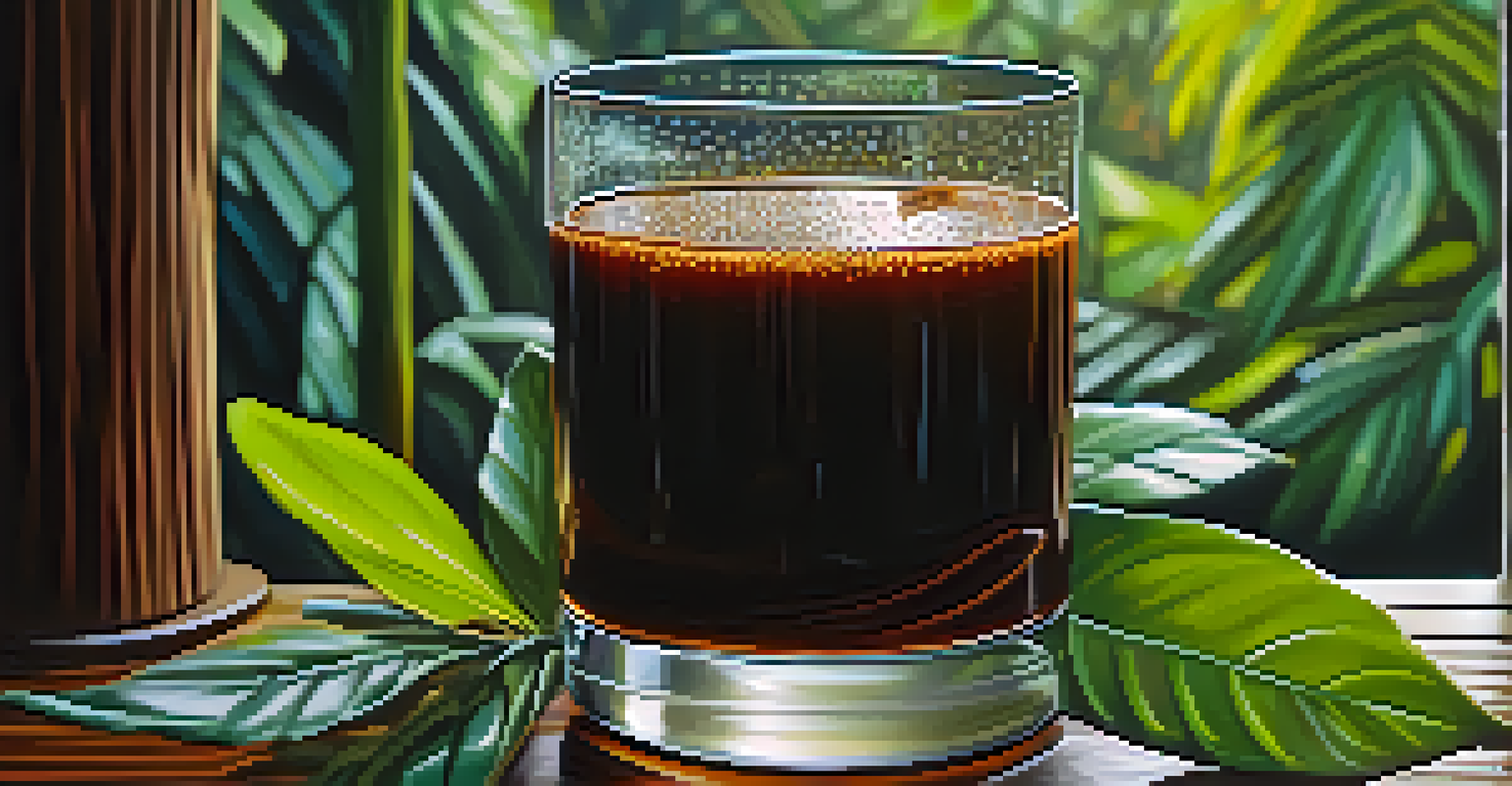The Science Behind Ayahuasca and Mystical Experiences

What is Ayahuasca and Its Cultural Significance?
Ayahuasca is a traditional brew made from the Banisteriopsis caapi vine and other plants, primarily used in Amazonian shamanic practices. Its deep cultural roots span centuries, serving as a spiritual medicine to connect individuals with the divine. Many indigenous tribes view it as a sacred tool for healing and self-discovery, highlighting its importance in fostering community and spiritual growth.
Ayahuasca is a powerful tool for self-discovery and healing, allowing individuals to confront their deepest fears and traumas.
The brew is known for inducing powerful, altered states of consciousness, often referred to as mystical experiences. These experiences can provide profound insights into one’s life, relationships, and purpose, leading to transformative personal journeys. This rich tapestry of cultural significance and personal exploration is what draws many to ayahuasca ceremonies today.
As interest in ayahuasca grows beyond its traditional roots, it’s essential to respect and acknowledge its cultural origins. Engaging with indigenous practices responsibly ensures that the knowledge and reverence for ayahuasca are preserved, fostering a more respectful understanding of its significance.
The Psychedelic Components of Ayahuasca Explained
The primary psychoactive compound in ayahuasca is DMT (dimethyltryptamine), a substance that occurs naturally in many plants and even in the human body. When combined with the MAO inhibitors found in the caapi vine, DMT becomes orally active, allowing users to experience its profound effects. This combination is what sets ayahuasca apart from other psychedelics, as it creates a unique and extended journey.

DMT is often referred to as the 'spirit molecule' due to the intense mystical experiences it can evoke. Users frequently report feelings of interconnectedness, deep introspection, and encounters with otherworldly entities. These experiences can be both enlightening and challenging, often leading participants to confront personal fears and unresolved issues.
Ayahuasca's Cultural Significance
Ayahuasca serves as a sacred tool for healing and self-discovery in Amazonian shamanic traditions.
Understanding the science behind these compounds helps demystify the ayahuasca experience. It also opens doors for further research into its therapeutic potential, particularly for mental health conditions like depression and PTSD, where traditional treatments may fall short.
Mystical Experiences: What Are They Really?
Mystical experiences are often characterized by feelings of unity, transcendence, and a deep sense of understanding. During ayahuasca ceremonies, participants may encounter such experiences, which can feel profoundly real and life-changing. These moments can lead to shifts in perspective, enhancing one's appreciation for life and connection to others.
The experience of ayahuasca can lead to profound insights and a transformative understanding of one's place in the universe.
Research shows that mystical experiences can have lasting effects on an individual's psychological well-being. Many report increased openness, reduced anxiety, and a greater sense of purpose following these experiences. This alignment with positive mental health outcomes makes exploring the mechanisms behind ayahuasca even more compelling.
Understanding the nature of these experiences helps to clarify their impact on personal growth and healing. By analyzing how ayahuasca facilitates such profound insights, we can better appreciate its potential role in therapeutic settings.
The Role of Set and Setting in Ayahuasca Journeys
Set and setting refer to the mindset of the participant and the physical environment in which the experience occurs. These factors play a crucial role in shaping the ayahuasca experience, influencing how participants perceive and process their journey. A supportive, safe environment can foster positive experiences, while a chaotic or uncomfortable setting may lead to challenging encounters.
In many ceremonies, trained facilitators or shamans create a structured and nurturing atmosphere to help guide participants through their experiences. This guidance is essential, as it can provide reassurance and support during difficult moments. Moreover, the collective energy of the group often enhances individual journeys, leading to shared insights and healing.
Therapeutic Potential of Ayahuasca
Preliminary studies suggest ayahuasca may effectively treat mental health conditions like depression and PTSD.
Recognizing the importance of set and setting emphasizes the need for responsible practices in ayahuasca ceremonies. Ensuring a safe and supportive environment allows participants to explore their inner landscapes with greater confidence and clarity.
Neuroscience Behind Ayahuasca and Mystical States
Recent advancements in neuroscience have begun to uncover how ayahuasca affects the brain during mystical experiences. Studies using brain imaging techniques reveal changes in brain activity patterns, particularly in areas associated with consciousness and emotion. These findings provide a biological basis for the profound insights and emotional healing that many participants report.
One key observation is the increased connectivity between different brain regions during ayahuasca experiences, which may explain the feelings of unity and interconnectedness. This enhanced connectivity can lead to a more integrated perception of oneself and the world, transforming how individuals approach their lives post-ceremony.
As researchers continue to explore the effects of ayahuasca, we get closer to understanding its potential therapeutic applications. By bridging the gap between ancient practices and modern science, we can appreciate the full scope of ayahuasca’s impact on the human psyche.
Therapeutic Potential of Ayahuasca in Mental Health
The therapeutic potential of ayahuasca is increasingly being recognized in the field of mental health. Preliminary studies suggest that ayahuasca may be effective in treating conditions such as depression, anxiety, and PTSD. The insights gained during ceremonies can lead to significant breakthroughs, helping individuals confront their traumas and emotional struggles.
Participants often describe a sense of clarity and resolution following their ayahuasca journeys, which can be invaluable for those battling mental health issues. This process of introspection and healing is particularly powerful in a supportive setting, where individuals feel safe to explore their emotions.
Importance of Set and Setting
The mindset of participants and the physical environment are crucial factors that influence the ayahuasca experience.
While more rigorous research is needed to fully understand its efficacy, the early findings highlight ayahuasca’s potential as a complementary treatment option. As mental health continues to be a global concern, exploring innovative approaches like ayahuasca could pave the way for new solutions.
Cautions and Considerations for Ayahuasca Use
Despite its potential benefits, there are important cautions to consider when approaching ayahuasca. As with any powerful substance, individual experiences can vary widely, and not everyone will have a positive journey. It’s crucial to approach ayahuasca with respect, understanding, and preparation to ensure a safe and constructive experience.
Health conditions, medications, and personal history can all influence how one responds to ayahuasca. Consulting with a healthcare professional before participating in a ceremony is advisable, particularly for those with underlying health issues or taking certain medications. Understanding these factors can help mitigate risks and enhance the potential for positive outcomes.

Ultimately, being informed and prepared is key to navigating the complexities of ayahuasca use. By acknowledging both its potential and its risks, individuals can approach their journeys with greater awareness and intention.